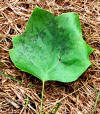 The growth is actually a
form of a fungal (mold) growth called sooty mold.
However, that is not the real problem. Sooty mold is
actually a sign of a serious infestation of some type of
sucking insect such as
aphids,
scales,
mealybugs,
whiteflies or occasionally,
spider mites.
The growth is actually a
form of a fungal (mold) growth called sooty mold.
However, that is not the real problem. Sooty mold is
actually a sign of a serious infestation of some type of
sucking insect such as
aphids,
scales,
mealybugs,
whiteflies or occasionally,
spider mites.
These critters are
sucking the juices out of leaves above and then their
droppings fall onto the leaves below. This substance is
commonly called "honeydew" and it is full of sugars and
is very sticky. Once it accumulates, the fungal spores
of sooty mold begin to grow and turn the leaf or needle
black.
Although the mold is
generally on the same plant that is infested by the
insects, it may also appear on plants growing beneath.
Often, you might see
hosta plants that have sooty mold
on their leaves that is caused by an infested tree
above.
In severe cases, the mold
may build to a thickness that blocks the light from
entering the leaf. Then, it will cause the leaf to lose
its chlorophyll, turn yellow and lose energy. This may
also weaken the plant further.



